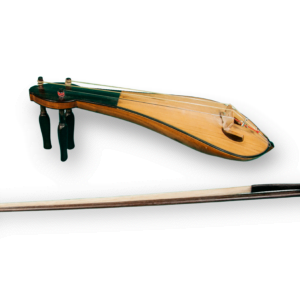- Call us
- Via Vicolo Galletti 2 , 48013 Brisighella (RA) / Italy
- WORLDWIDE FREE SHIPPING
Classical Kemence
The Classical Kemence, also known as the Turkish Violin, has a rich history that dates back centuries. Its origins can be traced to the traditional music of the Ottoman Empire and the broader cultural heritage of Anatolia
Showing the single result
About Classical Kemence
The Classical Kemence is typically made of wood, and three or four strings. Its unique construction and design contribute to its distinctive sound and expressive capabilities. With its resonating soundbox, curved bridge, and slender neck, the Classical Kemence offers a wide range of melodic possibilities and rich tonal colors.
The klasik kemençe, also known as the armudî kemençe (“pear-shaped kemençe”) or poliliki lyra (“Constantinopolitan lyre”), is a fascinating bowed instrument with a rich history in Turkish music. Here’s a closer look at this unique piece:
Origins and Design:
- Believed to be derived from the medieval Byzantine lyre, the klasik kemençe has a distinctive pear-shaped body, earning it the “armudî” nickname.
- Its history stretches back to at least the 10th century, and it played a significant role in both Ottoman classical music and Greek folk music, particularly early Rebetiko.
Distinct Characteristics:
- Unlike most Western bowed instruments, the klasik kemençe has no frets. Instead, the strings are pressed from the side using fingernails to change pitches.
- Traditionally played with three strings, a fourth string was added in the mid-19th century.
- The instrument is typically held on the lap or knees while the player uses a bow in the right hand and the left hand on the fingerboard.
- Its size is relatively small, with a typical body length around 40-41 centimeters.
Sound and Role in Music:
- The klasik kemençe produces a warm, rich sound that stands out in ensembles.
- It became the primary bowed instrument in Ottoman classical music by the mid-19th century and remains an important part of the tradition today.
Tapadum Music Store celebrates the legacy and heritage of the Classical Kemence by offering a wide range of instruments that showcase the finest craftsmanship and exquisite sound quality. With our collection of Classical Kemences, we aim to preserve the tradition, artistry, and cultural significance of this remarkable instrument.
The design of the classical kemence is elegant and distinctive. It typically features a small, pear-shaped body carved from a single block of wood, often mulberry or juniper, contributing to its resonant and rich sound. The soundboard is usually made from thin spruce wood, allowing for clear and vibrant tones. Traditionally, the instrument had three strings, but modern versions may have four.
One of the most striking features of the classical kemence is its unique playing technique. Unlike many other bowed string instruments, the kemence is held upright, with the player using a bow to draw sound from the strings. The player’s left hand manipulates the strings on the neck of the instrument to produce different pitches and ornamentations, while the right hand controls the bowing motion, allowing for nuanced dynamics and expression.
In Turkish traditional music, the classical kemence plays a vital role, often serving as a solo instrument or as part of an ensemble. Its haunting melodies and intricate ornamentations evoke a wide range of emotions, from joyous celebration to melancholic reflection. It is commonly featured in folk dances, ceremonial rituals, and musical performances, where its distinctive timbre adds depth and authenticity to the music.
Free Shipping
To Europe & %0 Custom Tax
15 Days Warranty
15 days money back
Global Shipping
Worldwide Shipping
100% Secure
100% Secure Checkout


